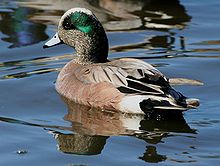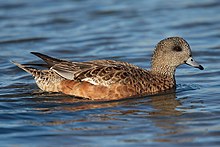American wigeon
| American wigeon | |
|---|---|
 |
|
| Male | |
 |
|
| Female | |
| Scientific classification | |
| Kingdom: | Animalia |
| Phylum: | Chordata |
| Class: | Aves |
| Order: | Anseriformes |
| Family: | Anatidae |
| Subfamily: | Anatinae |
| Genus: | Anas |
| Subgenus: | Mareca |
| Species: | A. americana |
| Binomial name | |
|
Anas americana Gmelin, 1789 |
|
| Synonyms | |
|
Mareca americana (but see text) |
|
Mareca americana (but see text)
The American wigeon (Anas americana), also baldpate, is a species of dabbling duck found in North America. This species is classified with the other wigeons in the dabbling duck genus Anas, which may be split, in which case wigeons could go into their old genus Mareca again. It is the New World counterpart of the Eurasian wigeon. Anas is the Latin for "duck" and americana refers to America.
The American wigeon is a medium-sized bird; it is larger than a teal, but smaller than a pintail. In silhouette, the wigeon can be distinguished from other dabblers by its round head, short neck, and small bill. It is 42–59 cm (17–23 in) long, with a 76–91 cm (30–36 in) wingspan and a weight of 512–1,330 g (1.129–2.932 lb). This wigeon has two adult molts per year and a juvenile molt in the first year, as well.
The breeding male (drake) is a striking bird with a mask of green feathers around its eyes and a cream colored cap running from the crown of its head to its bill. This white patch gives the wigeon its other common name, baldpate (pate is another word for head). Their belly is also white. In flight, drakes can be identified by the large white shoulder patch on each wing. These white patches flash as the birds bank and turn. In non-breeding (eclipse) plumage, the drake looks more like the female.
The hens are much less conspicuous, having primarily gray and brown plumage. Both sexes have a pale blue bill with a black tip, a white belly, and gray legs and feet. The wing patch behind the speculum is gray. They can be distinguished from most ducks, apart from Eurasian wigeon, by shape. However, that species has a darker head and all grey underwing. The head and neck coloring of the female is different as opposed to the Eurasian wigeon. It nests on the ground, near water and under cover. It lays 6–12 creamy white eggs. Flocks will often contain American coots.
The American wigeon is a noisy species, and in the field can often be identified by their distinctive calls. Drakes produce a three note whistle, while hens emit hoarse grunts and quacks. The male whistle makes a wheezy whoee-whoe-whoe, whereas the female has a low growl qua-ack.
...
Wikipedia

